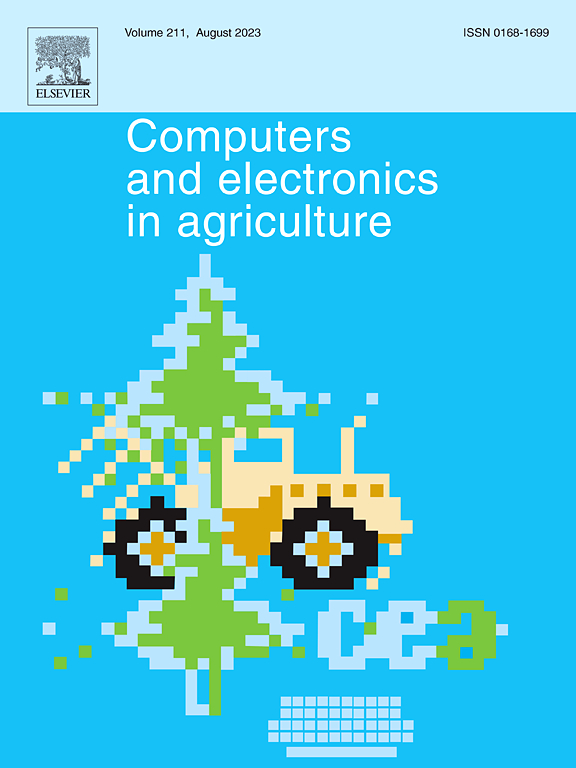二维近似沟渗模型中参数γ的估计方法
IF 8.9
1区 农林科学
Q1 AGRICULTURE, MULTIDISCIPLINARY
引用次数: 0
摘要
本研究扩展了Bautista等人提出的近似沟渗模型(FIM)中参数γ的分析。在此基础上,建立了灰狼优化(GWO) -反向传播神经网络(BPNN) -自适应增强(AdaBoost)回归模型,并将其γ预测性能与BPNN模型和BPNN - AdaBoost模型进行了比较。结果表明,沟横截面、土壤质地和水深(h0)对边缘效应(ΔI)和γ有显著影响,γ在0.60 ~ 0.94之间。边缘效应对总沟入渗的相对贡献率为21.0% ~ 41.7%。采用偏差(Bias)、均方根误差(RMSE)和决定系数(R2)三个性能指标来评估所提出模型的性能。结果表明,以沟深(D)、底宽(B)、顶宽(T)、n、α、饱和导水率(Ks)、h0、有效饱和度(Se)为输入因子,GWO-BPNN-AdaBoost模型的偏差、RMSE和R2的γ值分别为-0.0009、0.062和0.851,具有较高的精度。利用模型预测的γ值计算二维累积入渗。其中,GWO-BPNN-AdaBoost模型的预测结果与Hydrus-2D模拟结果最接近,偏差、RMSE和R2值分别为-0.53、1.41 cm和0.993 cm。结果表明,GWO-BPNN-AdaBoost可以更准确地估计γ。本文章由计算机程序翻译,如有差异,请以英文原文为准。
Method for estimating parameter γ in a two-dimensional approximate furrow infiltration model
This study expands the analysis of the parameter γ in the approximate furrow infiltration model (FIM) proposed by Bautista et al. On the basis of the obtained results, a gray wolf optimization (GWO)–backpropagation neural network (BPNN)–adaptive boosting (AdaBoost) regression model was developed, and its γ prediction performance was compared with that of a BPNN model and BPNN–AdaBoost model. The results indicated that furrow cross section, soil texture, and water depth (h0) considerably influence the edge effect (ΔI) and γ, with γ ranging from 0.60 to 0.94. Moreover, the edge effect’s relative contribution to the total furrow infiltration is 21.0 %–41.7 %. Three performance measures, namely Bias, root mean square error (RMSE), and coefficient of determination (R2), were employed to evaluate the performance of the proposed models. The results revealed that γ values of Bias, RMSE, and R2 were –0.0009, 0.062, and 0.851 for the GWO–BPNN–AdaBoost model has the high accuracy, respectively, with furrow depth (D), bottom width (B), top width (T), n, α, saturated hydraulic conductivity (Ks), h0, effective saturation (Se) as input factors. The two-dimensional cumulative infiltration was calculated using the γ values predicted by the models. Among these predictions, those produced by the GWO–BPNN–AdaBoost model most closely aligned with the simulated values acquired using Hydrus-2D, with the Bias, RMSE, and R2 values being –0.53, 1.41 cm, and 0.993, respectively. Based on analysis of the obtained results, it is evident that GWO–BPNN–AdaBoost can estimate γ more accurately.
求助全文
通过发布文献求助,成功后即可免费获取论文全文。
去求助
来源期刊

Computers and Electronics in Agriculture
工程技术-计算机:跨学科应用
CiteScore
15.30
自引率
14.50%
发文量
800
审稿时长
62 days
期刊介绍:
Computers and Electronics in Agriculture provides international coverage of advancements in computer hardware, software, electronic instrumentation, and control systems applied to agricultural challenges. Encompassing agronomy, horticulture, forestry, aquaculture, and animal farming, the journal publishes original papers, reviews, and applications notes. It explores the use of computers and electronics in plant or animal agricultural production, covering topics like agricultural soils, water, pests, controlled environments, and waste. The scope extends to on-farm post-harvest operations and relevant technologies, including artificial intelligence, sensors, machine vision, robotics, networking, and simulation modeling. Its companion journal, Smart Agricultural Technology, continues the focus on smart applications in production agriculture.
 求助内容:
求助内容: 应助结果提醒方式:
应助结果提醒方式:


